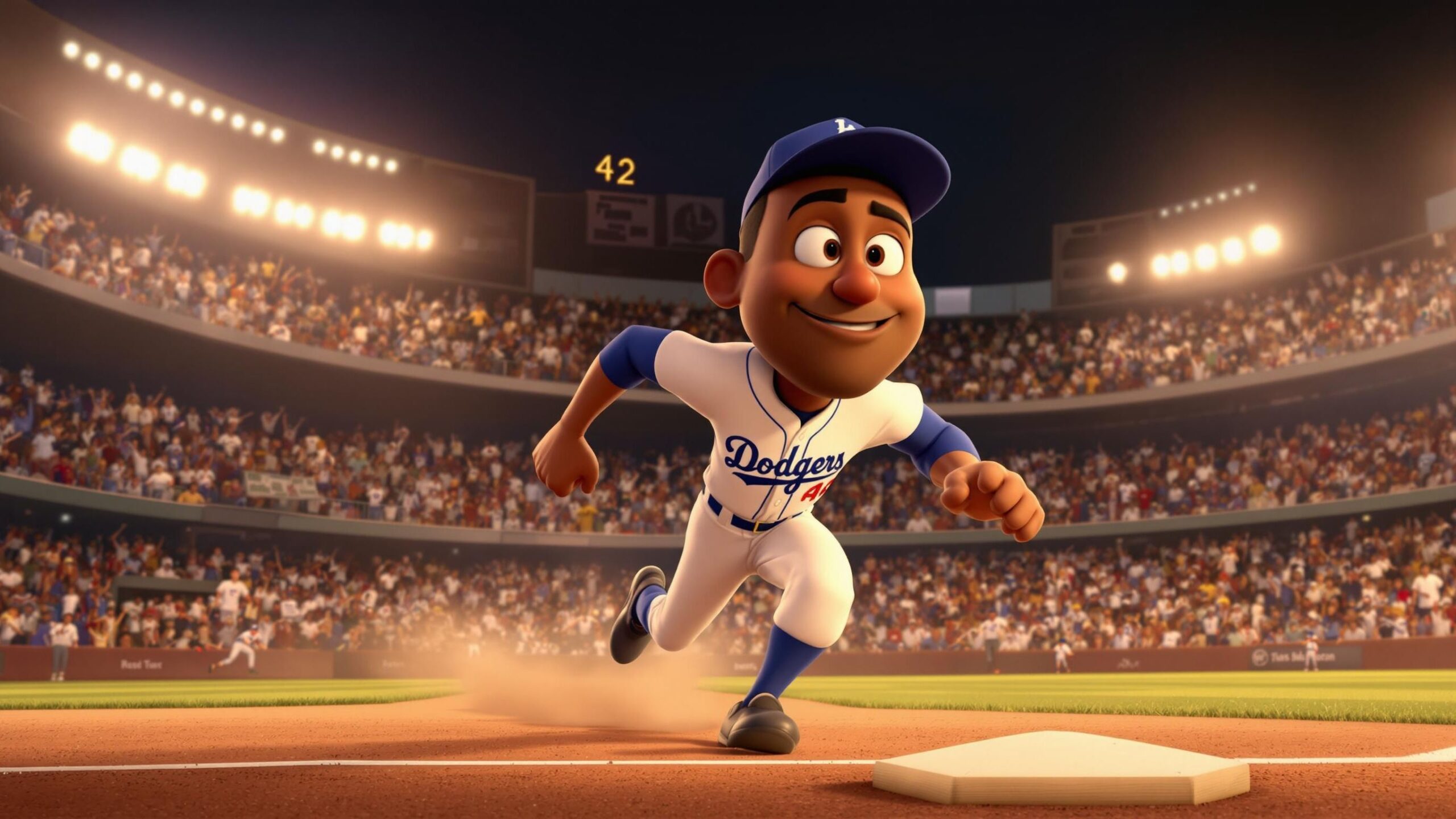Long before the age of endorsement deals, viral highlights, and 24/7 sports coverage, one man changed the very idea of what it meant to be a superstar. He didn’t just play baseball—he made it bigger, louder, and unforgettable. He was the reason stadiums overflowed, headlines screamed, and kids everywhere dreamed of hitting it out of the park. His name? Babe Ruth. A name that didn’t just echo through ballparks—it thundered across a growing nation hungry for heroes. In the 1920s and ‘30s, Babe Ruth wasn’t just a player; he was a phenomenon. With a bat like Thor’s hammer and a swagger that could silence doubters from the dugout, he turned every game into a grand performance. Whether it was launching jaw-dropping home runs or lighting up the tabloids with his outrageous lifestyle, Ruth lived large—and America loved him for it. He wasn’t a man trying to fit into the world of baseball; he reshaped the world around him. This is the story of how a troublemaking kid from Baltimore became the Sultan of Swat, transformed the New York Yankees into legends, and carved his name into the mythos of American sports. It’s a tale of towering homers, wild nights, fierce loyalty, and one man’s unforgettable rise to immortality. So, grab your peanuts and crackerjack—because Babe Ruth’s story is as thrilling as the game, he made great.
The Birth of a Legend: From the Streets of Baltimore
Before the crowds, fame, and towering home runs, Babe Ruth was simply George Herman Ruth Jr.—a boy growing up in the rough neighborhoods of Baltimore in the late 19th century. His early life wasn’t one of glamor or privilege. Raised in a working-class family, Ruth was often unruly and in trouble. His parents struggled to manage him, eventually sending him to St. Mary’s Industrial School for Boys, a reformatory and orphanage. But what seemed like a punishment turned out to be fate’s curveball. At St. Mary’s, Ruth met Brother Matthias, a figure who would not only bring discipline into his life but also introduce him to baseball. Brother Matthias recognized Ruth’s natural talent and raw power. Young George could hit the ball farther than anyone else, and he quickly developed his skills as both a pitcher and a batter. By his late teens, Ruth’s prowess was undeniable. His booming hits, precise pitching, and boundless energy turned heads, and soon, the Boston Red Sox signed the young talent. From these humble and troubled beginnings, a baseball giant was born.
The Great Bambino Breaks In
When Babe Ruth joined the Boston Red Sox in 1914, he was primarily known for his pitching. And what a pitcher he was. In the 1916 season, Ruth posted a 23–12 record with a microscopic 1.75 ERA and nine shutouts. But it didn’t take long for his hitting to steal the spotlight. With a bat in hand, Ruth was explosive. He smashed balls with unprecedented power and made fans sit up and cheer in awe. His presence at the plate was electric. Despite his success as a pitcher, Ruth’s undeniable batting talent forced the Red Sox to move him into the everyday lineup. Fans began to pack stadiums not just to see the Red Sox win—but to see what Babe Ruth might do next. The legend of the “Great Bambino” had begun to take hold. Yet, his time in Boston would not last. In 1919, after a dispute over salary and financial pressure on the team’s owner, Ruth was sold to the New York Yankees. This trade would become one of the most consequential in sports history. Boston fans would mourn, but the city of New York was about to embrace their new hero with open arms.
The Sultan of Swat Transforms the Yankees
Babe Ruth’s arrival in New York was a seismic event. The Yankees, a team that had never won a championship, were suddenly thrust into the spotlight. With Ruth’s larger-than-life personality and his even bigger bat, they quickly became the most talked-about team in baseball. In 1920, Ruth shattered his own home run record with 54 homers, single-handedly making the long ball the centerpiece of modern baseball. Fans were obsessed. He was magnetic. By the early 1920s, Ruth was no longer just an athlete—he was a superstar, a household name, a folk hero. Yankee Stadium was dubbed “The House That Ruth Built,” and with good reason. His presence filled the stands night after night, bringing unprecedented attention—and revenue—to the sport. Ruth’s home runs weren’t just numerous; they were dramatic. Towering shots that seemed to scrape the sky and land in distant parts of the ballpark. He turned baseball into a spectacle, and in the process, transformed the Yankees into a dynasty.
The Roaring Twenties and America’s First Celebrity Athlete
In many ways, Babe Ruth embodied the spirit of the Roaring Twenties. Bold, extravagant, uncontainable—he was a man of the moment. He smoked cigars, enjoyed lavish parties, rode in limousines, and befriended everyone from bootleggers to Broadway stars. His lifestyle was as headline-worthy as his performance on the field. Magazines and newspapers couldn’t get enough of him. He was on billboards, in radio ads, and even in films. Children collected his baseball cards like gold. America had never seen a sports figure like this before—a man who transcended the game and became a cultural force. Despite his off-field antics, Ruth remained a dominant force between the baselines. His peak years with the Yankees were the stuff of legend. Seasons with 50 or more home runs, batting titles, slugging percentages that broke records—it was as if he had created his own personal league.
The Called Shot and World Series Glory
If one moment defines the myth of Babe Ruth, it might be his famous “called shot” during the 1932 World Series. Playing against the Chicago Cubs, Ruth allegedly pointed to the center field bleachers before hitting the very next pitch over the fence. While historians still debate whether the gesture was truly a prediction or just playful showmanship, the legend stuck. It was classic Ruth—bold, theatrical, and unforgettable. Ruth’s postseason legacy is equally awe-inspiring. He helped lead the Yankees to seven American League pennants and four World Series titles during his tenure. He was a clutch performer when it mattered most, delivering game-changing hits and towering home runs in crucial moments. Fans didn’t just admire him—they worshipped him.
The Man Behind the Myth
Babe Ruth’s public image was one of excess and power, but the man himself was more complex. He was known to be generous, particularly with children and fans. He often visited hospitals, gave away autographs by the hundreds, and donated to charitable causes. Despite his wild lifestyle, there was an undeniable kindness at his core. Ruth’s relationships were as unpredictable as his batting average. His first marriage ended in tragedy, and he was often away from home due to baseball and his social obligations. Still, those close to him spoke of a man who cared deeply about the game, his teammates, and his legacy. He never forgot his roots in Baltimore, or the role St. Mary’s School played in shaping his life. Later in life, he often credited Brother Matthias with saving him—not just from a troubled youth, but from a life that could have easily unraveled without discipline and direction.
Chasing a New Dream: The End of an Era
As Ruth’s career began to wind down in the 1930s, he sought new challenges. He desperately wanted to manage a major league team, believing that his knowledge and charisma would make him a natural leader. But team owners were hesitant. His reputation for indulgence and his lack of coaching experience worked against him. Despite his stardom, Ruth was never offered a managerial position in the majors. His final playing years were with the Boston Braves in 1935, a bittersweet return to the city where it all began. Though his body had slowed and his power had faded, fans still came out in droves to catch one last glimpse of the legend. On May 25, 1935, Ruth hit three home runs in a single game—his final hurrah before retiring from professional baseball.
A Farewell Fit for a King
Babe Ruth’s impact on baseball was so profound that even in retirement, he remained the sport’s most iconic figure. When he was diagnosed with cancer in the late 1940s, fans across the nation mourned. The man who had brought joy to millions was now battling his greatest foe. On June 13, 1948, the Yankees held a ceremony at Yankee Stadium in his honor. Frail and weakened, Ruth stood before a packed house, speaking softly to a crowd that cheered him with tearful admiration. Two months later, on August 16, 1948, Babe Ruth passed away at the age of 53. More than 75,000 people lined up to pay their respects as he lay in state at Yankee Stadium. His funeral was a national event. Newsreels played tributes, radio stations paused for silence, and newspapers ran full-page obituaries. Ruth was more than a player—he was a symbol of a generation, a beacon of hope during hard times, and a reminder of what it meant to dream big.
The Legacy That Lives On
Decades after his death, Babe Ruth remains a towering figure in the world of sports. His records, many of which stood for decades, are now history, but his myth endures. His name is synonymous with greatness. Baseball historians still debate where he ranks on the all-time list, but there’s no argument about one thing: Babe Ruth changed everything. He helped usher in the modern era of sports. He made baseball America’s pastime. He turned athletes into celebrities and inspired generations to pick up a bat. He was the first to show that being great at a game could mean becoming great in the eyes of a nation. From candy bars to postage stamps, video games to films, his image continues to appear in American culture. He’s not just remembered—he’s revered. Babe Ruth was the embodiment of the American dream. He came from nothing, rose to unmatched heights, fell, and rose again. He was flawed, human, and heroic all at once. In a time before social media, before TV, before 24-hour sports coverage, he became the biggest star in the world. And he did it with a smile, a swagger, and a swing. He redefined baseball and remade the role of the athlete in American life. He wasn’t simply great at the game—he turned the game into theater, spectacle, and magic. Ruth made kids believe they could be superheroes with just a bat, a glove, and a dream. He made struggling Americans in the Great Depression smile and believe in miracles. Every time he stepped to the plate, it felt like anything could happen. And that’s what makes Babe Ruth immortal. Today, his legacy lives not only in Cooperstown, in highlight reels, or in sports documentaries, but in every child who picks up a bat and swings for the fences. He paved the way for modern sports heroes—long before Jordan, Ali, or LeBron—proving that an athlete could be more than just a competitor. They could be icons, legends, and symbols of hope. Babe Ruth didn’t just play baseball. He became baseball. And in doing so, he became America’s first sports hero—the one by which all others are still measured.




